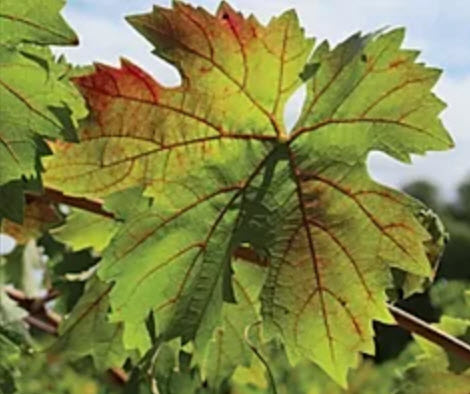
Grapevine Red Blotch Disease
Origin: Grapevine red blotch disease is of unknown origin at this time, but it may have been in the U.S. for several years since it appears to be widely distributed in North America and Canada. First noticed in 2007 at the UC Davis Oakville research station, the virus wasn’t identified until 2012, and much remains unknown about its causes or ways to manage it.
Current distribution: Findings suggest an extensive geographic distribution, as well as occurrences in both red and white Vitis vinifera vines. Infected vines have been identified in California, Maryland, New York, Oregon, Pennsylvania, Texas, Virginia, and Washington. In California, grapevine red blotch disease has been detected in vineyards in the North Coast, Central Coast, and San Joaquin Valley. The disease appears in both young (first leaf) and mature (five to 20-year-old) vineyards.
Biology: Grapevines infected with grapevine red blotch disease show symptoms much like that of vine leafroll disease, where leaves turn red in the early fall, primarily at the base of shoots. Unlike leafroll, which exhibits green veins in the leaves, red blotch vines have red or pink veins in the leaves, red blotches on the leaves, and no rolling.
Host Range: Grapevine red blotch disease has been detected in Cabernet Franc, Cabernet Sauvignon, Chardonnay, Malbec, Merlot, Mourvèdre, Petite Syrah, Petit Verdot, Pinot Noir, Riesling, and Zinfandel. It is believed to infect table grapes, raisin grapes, and rootstock as readily as winegrapes. Non-grape hosts are currently unknown.
How it Spreads: The virus is spread by grafting and propagation of infected plant material and by insect vectors, such as the three-cornered alfalfa hopper. It is not known if grapevine red blotch disease can be spread by unsanitary equipment (i.e., mechanical transmission).
Potential Damage: Grapevine red blotch disease consistently reduces sugar accumulation, increases malic acid, and less consistently increases pH and titratable acidity. Cluster weight may be reduced and the effect of yield varies by cultivar and growing conditions. Pruning weight has also been shown to be reduced by five percent in infected Cabernet franc and Merlot vines. Much is still unknown about its effect on yield and in different cultivars and rootstocks. Currently, the only treatment is to remove the entire vine.

